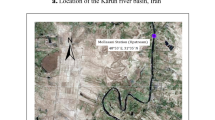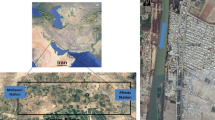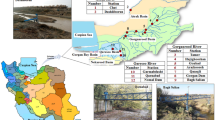Abstract
Hydraulic models have a substantial role in the simulation of rivers due to their high accuracy and low cost. One of the most practical hydraulic models is HEC-RAS capable of simulating all flow conditions in watercourses. Floods occurring in rivers are highly dependent on Manning's Roughness Coefficient (MRC). Its optimization, calibration, and uncertainty analysis are necessary. To this end, HEC-RAS should be automated and linked by optimization models so that it can seek to find the optimal values using an iterative process. In this research, HEC-RAS was automated in MATLAB2019 and linked with Particle Swarm Optimization (PSO) and Mont Carlo Simulation (MCS). The sensitivity analysis of PSO was performed, and its optimal coefficients were determined. The MRC calibration was done in the Shahab River in Hamadan province (Iran). The results showed that the MRC in the three distinguished reaches (from upstream to downstream) were respectively obtained as 0.061, 0.057, and 0.040 in the main channel and 0.069, 0.059, and 0.046 in the floodplain. Comparing the obtained values from optimization and estimated values by traditional methods revealed that the optimal values are lower than the estimated ones. The results of the uncertainty analysis of six hydraulic parameters showed that the uncertainty of the velocity is higher than the others. According to the results, the uncertainty is high, therefore, it is recommended MRC is determined with sufficient accuracy to reduce the financial costs and human losses caused by floods.











Similar content being viewed by others
Availability of Data and Materials
Datasets are available upon request.
Notes
Hydrologic Engineering Center- River Analysis System.
National Center for Computation Hydro-Science and Engineering 2D tool.
Storm Water Management Model.
Simulation of Irrigation Canals.
Irrigation Canal System Simulation.
References
Abbas SA, Al-Aboodi AH, Ibrahim HT (2020) Identification of Manning’s coefficient using HEC-RAS model: upstream Al-Amarah barrage. J Eng
Agresta A, Baioletti M, Biscarini C, Caraffini F, Milani A, Santucci V (2021) Using optimisation meta-heuristics for the roughness estimation problem in river flow analysis. Appl Sci 11(22):10575
Ardıçlıoğlu M, Kuriqi A (2019) Calibration of channel roughness in intermittent rivers using HEC-RAS model: Case of Sarimsakli creek, Turkey. SN Appl Sci 1(9):1–9
Azamathulla HM, Jarrett RD (2013) Use of gene-expression programming to estimate Manning’s roughness coefficient for high gradient streams. Water Resour Manag 27(3):715–729
Bates BC, Townley LR (1988) Nonlinear, discrete flood event models, 3. Analysis of prediction uncertainty. J Hydrol 99(1–2):91–101
Clerc M (2010) Particle swarm optimization. John Wiley & Sons
Clerc M, Kennedy J (2002) The particle swarm-explosion, stability, and convergence in a multidimensional complex space. IEEE Trans Evol Comput 6(1):58–73
Cowan WL (1956) Estimating hydraulic roughness coefficients. Agric Eng 37(7):473–475
Daneshfaraz R, Dasineh M, Ghaderi A (2019) Evaluation of scour depth around bridge piers with HEC-RAS (case study: Bridge of Simineh Rood, Miandoab, Iran). Environ Water Eng 5(2):91–102
Deshays R, Segovia P, Duviella E (2021) Design of a MATLAB HEC-RAS interface to test advanced control strategies on water systems. Water 13(6):763
Garrote J, González-Jiménez M, Guardiola-Albert C, Díez-Herrero A (2021) The manning’s roughness coefficient calibration method to improve flood hazard analysis in the absence of river bathymetric data: Application to the urban historical zamora city centre in spain. Appl Sci 11(19):9267
Goodell C (2014) Breaking the HEC-RAS Code: A user's guide to automating HEC-RAS, h2ls
Hadi ZN, Almansori NJH (2021) Estimation of manning coefficient for the section between Al-Hindiya barrage and Al-Kufa barrage utilizing HEC-RAS. Mate Today Proc
Kennedy J (1998) The behavior of particles. Proc Int Conf Evol Prog, Springer 579–589
Kennedy J, Eberhart R (1995) Particle swarm optimization. Proc ICNN'95-Int Conf Neural Netw IEEE 1942–1948
Kim J-S, Lee C-J, Kim W, Kim Y-J (2010) Roughness coefficient and its uncertainty in gravel-bed river. Water Sci Eng 3(2):217–232
Mousavi F, Daneshfaraz R (2013) Evaluating various factors in calculation of scour depth around bridge piers using HEC-RAS Software, CSU2001 and Froehlich equations. J Civ Eng Urban 3(6):398–402
Moussa AMA (2018) Evaluation of local scour around bridge piers for various geometrical shapes using mathematical models. Ain Shams Eng J 9(4):2571–2580
Nohani E (2019) Estimating Manning’s roughness coefficient in rivers by experimental method. Online J Eng SciTechnol 2(1):5–10
Norouzi H, Bazargan J (2022) Calculation of water depth during flood in rivers using linear muskingum method and particle swarm optimization (PSO) Algorithm. Water Resour Manag 1–19
Parhi PK, Sankhua R, Roy G (2012) Calibration of channel roughness for Mahanadi River, (India) using HEC-RAS model. J Water Resour Prot 4(10):847–850
Serede IJ, Mutua BM, Raude JM (2015) Calibration of channel roughness coefficient for Thiba Main Canal Reach in Mwea irrigation scheme, Kenya. Hydrology 3(6):55–65
Shahverdi K, Alamiyan-Harandi F, Maestre J (2022) Double Q-PI architecture for smart model-free control of canals. Comput Electron Agric 197:106940
Shahverdi K, Maestre J, Alamiyan-Harandi F, Tian X (2020) Generalizing fuzzy SARSA learning for real-time operation of irrigation canals. Water 12(9):2407
Shi Y, Eberhart R (1998) A modified particle swarm optimizer. Proc., 1998 IEEE international conference on evolutionary computation proceedings. IEEE World Congress on Computational Intelligence (Cat. No. 98TH8360), IEEE, 69–73
Tork H, Javadi S, Shahdany SMH (2021) A new framework of a multi-criteria decision making for agriculture water distribution system. J Clean Prod 306:127178
Vatanchi SM, Maghrebi MF (2019) Uncertainty in rating-curves due to manning roughness coefficient. Water Resour Manag 33(15):5153–5167
Yang F, Wu J, Zhang Y, Zhu S, Liu G, Chen G, Wu S, Fan Z (2021) Improved method for identifying Manning’s roughness coefficients in plain looped river network area. Eng Appl Comput Fluid Mech 15(1):94–110
Yang J, Reichert P, Abbaspour KC, Xia J, Yang H (2008) Comparing uncertainty analysis techniques for a SWAT application to the Chaohe Basin in China. J Hydrol 358(1–2):1–23
Acknowledgements
The first author thanks Hamedan Reginal Water Authority for providing the Shahab river data.
Funding
The authors declare that no funds, grants, or other support were received during the preparation of this manuscript.
Author information
Authors and Affiliations
Contributions
Kazem Shahverdi: Conceptualized, coded, tested and, analyzed the model results and wrote the manuscript. Hossein Talebmorad: assisted in gathering data, providing the HEC-RAS model, conceptualizing, and analyzing the results, reviewed the manuscript, and gave constructive suggestions.
Corresponding author
Ethics declarations
Ethics Approval
Not applicable.
Consent to Participate
All authors give their consent to participate.
Consent to Publish
All authors give their consent to publish.
Competing Interests
The authors declare no competing interests.
Additional information
Publisher's Note
Springer Nature remains neutral with regard to jurisdictional claims in published maps and institutional affiliations.
Rights and permissions
Springer Nature or its licensor (e.g. a society or other partner) holds exclusive rights to this article under a publishing agreement with the author(s) or other rightsholder(s); author self-archiving of the accepted manuscript version of this article is solely governed by the terms of such publishing agreement and applicable law.
About this article
Cite this article
Shahverdi, K., Talebmorad, H. Automating HEC-RAS and Linking with Particle Swarm Optimizer to Calibrate Manning’s Roughness Coefficient. Water Resour Manage 37, 975–993 (2023). https://doi.org/10.1007/s11269-022-03422-8
Received:
Accepted:
Published:
Issue Date:
DOI: https://doi.org/10.1007/s11269-022-03422-8




